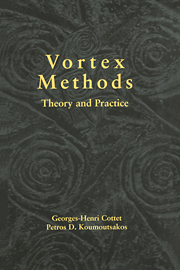Book contents
- Frontmatter
- Contents
- Preface
- 1 Definitions and Governing Equations
- 2 Vortex Methods for Two-Dimensional Flows
- 3 Three-Dimensional Vortex Methods for Inviscid Flows
- 4 Inviscid Boundary Conditions
- 5 Viscous Vortex Methods
- 6 Vorticity Boundary Conditions for the Navier–Stokes Equations
- 7 Lagrangian Grid Distortions: Problems and Solutions
- 8 Hybrid Methods
- Appendix A Mathematical Tools for the Numerical Analysis of Vortex Methods
- Appendix B Fast Multipole Methods for Three-Dimensional N-Body Problems
- Bibliography
- Index
8 - Hybrid Methods
Published online by Cambridge University Press: 21 September 2009
- Frontmatter
- Contents
- Preface
- 1 Definitions and Governing Equations
- 2 Vortex Methods for Two-Dimensional Flows
- 3 Three-Dimensional Vortex Methods for Inviscid Flows
- 4 Inviscid Boundary Conditions
- 5 Viscous Vortex Methods
- 6 Vorticity Boundary Conditions for the Navier–Stokes Equations
- 7 Lagrangian Grid Distortions: Problems and Solutions
- 8 Hybrid Methods
- Appendix A Mathematical Tools for the Numerical Analysis of Vortex Methods
- Appendix B Fast Multipole Methods for Three-Dimensional N-Body Problems
- Bibliography
- Index
Summary
In numerical simulations it is desirable to use numerical methods that are well suited to the physics of the problem at hand. As the dominant physics of a flow can vary in different parts of the domain, it is often advantageous to implement hybrid numerical schemes.
In this chapter we discuss hybrid numerical methods that combine, to various extents, vortex methods with Eulerian grid-based schemes. In these hybrid schemes, Lagrangian vortex methods and Eulerian schemes may be combined in the same part of the domain, in which each method is used in order to discretize different parts of the governing equations. Alternatively, vortex methods and grid-based methods can be combined in the same flow solver, in which each scheme resolves different parts of the domain. In this case we will discuss domain-decomposition formulations. Finally we consider the case of using different formulations of the governing equations in different parts of the domain. In that context we discuss the combination of the velocity–pressure formulation (along with grid-based methods) and the velocity–vorticity formulation (along with vortex methods) for the governing Navier–Stokes equations.
For simplicity, we often use in this chapter the terminology of finite-difference methods but it must be clear that in most cases the ideas can readily be extended to other Eulerian methods, such as finite-element or spectral methods.
One of the attractive features of vortex methods is the replacement of the nonlinear advection terms with a set of ordinary differential equations for the trajectories of the Lagrangian elements, resulting in robust schemes with minimal numerical dissipation.
Information
- Type
- Chapter
- Information
- Vortex MethodsTheory and Practice, pp. 237 - 260Publisher: Cambridge University PressPrint publication year: 2000
